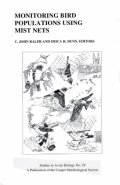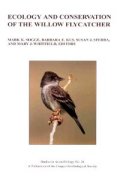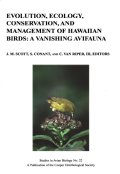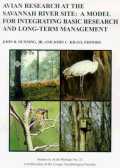|
|
|
Fire and Avian Ecology in North AmericaEditors: V. A. Saab and D. W. Powell
Studies In Avian Biology 30
Cooper Ornithological Society
2005
|
Buy from amazon.co.uk 
|
|
Monitoring Bird Populations Using Mist NetsEditors: C. John Ralph and Erica H. Dunn
Studies In Avian Biology 29
Cooper Ornithological Society
2004
Contents:
- Use of mist nets as a tool for bird population monitoring - Erica H. Dunn and C. John Ralph
- Effects of mist-netting frequency on capture rates at Monitoring Avian Productivity and Survivorship (MAPS) stations - Kenneth M. Burton and David F. DeSante
- Monitoring productivity with multiple mist-net stations - C. John Ralph, Kimberly Hollinger, and Sherri L. Miller
- Influence of mist-netting intensity on demographic investigations of avian populations - Grant Ballard, Geoffrey R. Geupel, and Nadav Nur
- Methodological considerations of the Monitoring Avian Productivity and Survivorship(MAPS) Program - David F. DeSante, James F. Saracco, Danielle R. O'Grady, Kenneth M. Burton, and Brett L. Walker
- Current practices in the British Trust for Ornithology Constant Effort Sites scheme and comparisons of temporal changes in mist-net captures with changes in spot-mapping counts at the extensive scale -
Will J. Peach, Stephen R. Baillie, and Stephen T. Buckland
- Relationship of juveniles captured in constant-effort netting with local abundance - Chris R. du Feu and John M. McMeeking
- Estimates of adult survival, capture probability, and recapture probability: evaluating and validating constant-effort mist netting -
Nadav Nur, Geoffrey R. Geupel, and Grant Ballard
- Estimating adult survival rates from between-year recaptures in the British Trust for Ornithology Constant Effort Sites scheme - Will J. Peach and Stephen R. Baillie
- A European example of standardized mist netting in population studies of birds - Andreas Kaiser and Peter Berthold
- Determining productivity indices from age composition of migrants captured for banding: problems and possible solutions - David J. T. Hussell
- An investigation of productivity indices derived from banding of fall migrants - Erica H. Dunn, David J. T. Hussell, and Raymond J. Adams
- Optimizing the allocation of count days in a migration monitoring program - Len Thomas, Geoffrey R. Geupel, Nadav Nur, and Grant Ballard
- Use of mist nets for monitoring landbird autumn population trends, and comparison with other methods - Peter Berthold
- A comparison of three count methods for monitoring songbird abundance during spring migration: capture, census, and estimated totals - Erica H. Dunn, David J. T. Hussell, Charles M. Francis, and Jon D. McCracken
- A comparison of constant-effort mist netting results at a coastal and inland New England site during migration - Christopher C. Rimmer, Steven D. Faccio, Trevor L. Lloyd-Evans, and John M. Hagan, III
- Mist netting trans-Gulf migrants at coastal stopover sites: the infl uence of spatial and temporal variability on capture data - Theodore R. Simons, Frank R. Moore, and Sidney A. Gauthreaux
- Bird population studies in Puerto Rico using mist nets: general patterns and comparisons with point counts - John Faaborg, Wayne J. Arendt, and Katie M. Dugger
- Coping with mist-net capture-rate bias: canopy height and several extrinsic factors - Elizabeth P. Mallory, Nicholas Brokaw, and Steven C. Hess
- Use of mist nets for study of neotropical bird communities - Andrew A. Whitman
- Some consequences of using counts of birds banded as indices to
populations - John R. Sauer and William A. Link
- On the use of capture–recapture models in mist-net studies - William L. Kendall, John R. Sauer, James D. Nichols, Roger Pradel, and James E. Hines
- Effectiveness of informal banding training at three western Canadian banding stations - Brenda C. Dale
- Recommendations for the use of mist nets for inventory and monitoring of bird populations - C. John Ralph, Erica H. Dunn, Will J. Peach, and Colleen M. Handel
|
 |
|
Noncooperative Breeding in the California Scrub-JayWilliam J. Carmen
Studies In Avian Biology 28
Cooper Ornithological Society
2004
From the abstract: "I studied the ecology, behavior, and demography of the noncooperatively breeding Western Scrub-Jay (Aphelocoma calfornica calfornica) in central coastal California. Cooperative breeding is ancestral in Aphelocoma jays and its loss in Western Scrub-Jays presents an opportunity for appropriate phylogenetic and ecological comparisons within the genus to identify key factors selecting for the alternative social systems. My intent was to gather comparative data to test several models for the evolution and maintenance of delayed dispersal and group living in birds, which were developed from long-term studies of cooperative breeders, including the closely related Florida Scrub-Jay (A. coerulescens) and Mexican Jay (A. ultramarina). The fundamental result of these comparisons is that models for the evolution of delayed dispersal and group living in birds fail as general explanations when floating is ignored or treated as a one-dimensional phenomenon. Factors that lead to delayed dispersal in cooperative species are known to be complex and may differ substantially among species and populations, and even among individuals within populations and groups. Conditions leading to early dispersal and floating may be equally complex. Clearly, opportunities for independent breeding are constrained in both cooperative and noncooperative populations. What then makes early dispersal and floating the preferred strategy in Western Scrub-Jays? Several factors play a part, including (1) the interplay between the pattern of habitat quality and acorn production, (2) the varied behaviors floaters may employ to exploit these resources and acquire breeding space, (3) the behavioral interactions between territorial jays and floaters, and (4) the ability of floaters to settle on low-quality territories and then, as breeders, to move and improve the quality of their territories."
|
 |
|
Ecology and Conservation of Birds of the Salton Sink: An Endangered EcosystemEditors: W. David Shuford and Kathy C. Molina
Studies In Avian Biology 27
Cooper Ornithological Society
2004
|
Buy from amazon.co.uk 
|
|
Ecology and Conservation of the Willow FlycatcherEditors: Mark K. Sogge, Barbara E. Kus, Susan J. Sferra, and Mary J. Whitfield
Studies In Avian Biology 26
Cooper Ornithological Society
2003
|
Buy from amazon.co.uk 
|
|
Effects of Habitat Fragmentation on Birds in Western Landscapes: Contrasts with Paradigms from the Eastern United StatesEditors: T. Luke George and David S. Dobkin
Studies In Avian Biology 25
Cooper Ornithological Society
2002
The contents are as follows.
- Introduction: Habitat fragmentation and western birds - T Luke George and David S. Dobkin
- A multi-scale perspective of the effects of forest fragmentation on birds in eastern forests - Frank R. Thompson, III, Therese M. Donovan, Richard M. DeGraaf, John Faaborg, and Scott K. Robinson
- What is habitat fragmentation - Alan B. Franklin, Barry R. Noon, and T Luke George
- Habitat edges and avian ecology: geographic patterns and insights for western landscapes - Thomas D. Sisk and James Battin
- Effects of fire and post-fire salvage logging on avian communities in conifer-dominated forests of the western United States - Natasha B. Kotliar, Sallie J. Hejl, Richard L. Hutto, Victoria A. Saab, Cynthia P Melcher, and Mary E. McFadzen
- Geographic variation in cowbird distribution, abundance, and parasitism - Michael L. Morrison and D. Caldwell Hahn
- Effects of forest fragmentation on brood parasitism and nest predation in eastern and western landscapes - John F. Cavitt and Thomas E. Martin
- Effects of forest fragmentation on tanager and thrush species in eastern and western North America - Ralph S. Hames, Kenneth V. Rosenberg, James D. Lowe, Sara E. Barker, and André A. Dhondt
- The effects of habitat fragmentation on birds in coast redwood forests - T. Luke George and Arriana Brand
- Effects of habitat fragmentation on birds in the coastal coniferous forests of the Pacific Northwest - David A. Manuwal and Naomi J. Manuwal
- Birds and changing landscape patterns in conifer forests of the north-central Rocky Mountains - Sallie J. Hejl, Diane Evans Mack, Jock S. Young, James C. Bednarz, and Richard L. Hutto
- Effects of habitat fragmentation on passerine birds breeding in intermountain shrubsteppe - Steven T Knick and John T. Rotenberry
- Habitat fragmentation effects on birds in southern California: contrast to the "top-down" paradigm - Douglas T Bolger
- Effects of anthropogenic fragmentation and livestock grazing on western riparian bird communities - Joshua J. Tewksbury, Anne E. Black, Nadav Nur, Victoria A. Saab, Brian D. Logan, and David S. Dobkin
- Spotted Owls, forest fragmentation, and forest heterogeneity - Alan B. Franklin and R. J. Gutiérrez
- Effects of forest fragmentation on populations of the Marbled Murrelet - Martin G. Raphael, Diane Evans Mack, John M. Marzluff, and John M. Luginbuhl
- Literature Cited
|
Buy from amazon.co.uk 
|
|
The Mountain White-Crowned Sparrow: Migration and Reproduction at High AltitudeMartin L. Morton
Studies In Avian Biology 24
Cooper Ornithological Society
2002
The contents are as follows.
- Abstract
- Preface
- Chapter 1: Introduction
- The zonotrichia
- Features of montane environments
- The study area
- Chapter 2: Migration arrival
- Arrival schedule
- Altitudinal movements
- Foraging
- Chapter 3: Social system snd behavior
- Territory establishment
- Pairing
- Between-year breeding dispersal
- Copulations
- Mate guarding
- Mate switching
- Mates per lifetime
- Age of mates
- Floaters
- Polygyny
- Aggression
- Vocalizations
- Chapter 4: Demography
- Life table
- Age structure of breeding population
- Chapter 5: Gonadal condition
- Gonadal changes
- Incubation (brood) patch
- Role of environmental cues in annual cycles
- Photoperiod effects
- Non-photoperiod effects
- Gonadal hormones
- Chapter 6: Body size and body condition
- Wing length and sex
- Wing length and age
- Seasonal changes in body mass
- Daily changes in body mass
- Chapter 7: Nests and eggs
- Nests
- Egg laying
- Description of eggs
- Egg dimensions
- Egg volume
- Weight loss of eggs during incubation
- Clutch size
- Incubation
- Chapter 8: Nestlings and fledglings
- Hatching
- Brood reduction
- Hatching asynchrony
- Sex ratio
- Cowbird parasitism
- Provisioning rates
- Nest sanitation
- Patterns of parental care
- Growth and thermoregulation in nestlings
- Natal dispersal
- Chapter 9: Nest failure
- Predation
- Desertion
- Storms
- Renesting
- Chapter 10: Reproductive success
- Annual reproductive success of nests
- Annual reproductive success of individuals
- Lifetime reproductive success
- Snow conditions
- Chapter 11: Late-season events
- Gonadal photorefractoriness
- Molt
- Timing of seasonal breeding
- Premigratory fattening
- Migration departure
- The stimulus for migration
- Stopover migrants and the migration schedule
- Chapter 12: Concluding remarks
- Acknowledgments
- Literature Cited
|
Buy from amazon.co.uk 
|
|
Geographic Variation in Size and Shape of Savannah Sparrows (Passerculus sandwichensis)James D. Rising
Studies In Avian Biology 23
Cooper Ornithological Society
2001
The contents are as follows.
- Abstract
- Introduction
- Materials and methods
- Results
- Non-saltmarsh savannah sparrows
- Univariate analyses of size
- Principal components analysis
- Discriminant functions analysis
- Correlations between environmental variables and size
- Canonical correlations and redundancy analysis
- Saltmarsh savannah sparrows
- Males
- Females
- Discussion
- Conclusions
- Taxonomic comments
- Eastern savannah sparrows
- Western savannah sparrows
- Saltmarsh savannah sparrows
- Acknowledgments
- Literature cited
- Appendix 1-measurements and sample statistics for males
- Appendix 2-measurements and sample statistics for females
|
 |
|
Evolution, Ecology, Conservation, and Management of Hawaiian Birds: A Vanishing AvifaunaEditors: J. M. Scott, S. Conant, and C. Van Riper, III
Studies In Avian Biology 22
Cooper Ornithological Society
2001
The contents are as follows.
- Introduction - J. Michael Scott, Sheila Conant, and Charles van Riper, III
- Introduction - Charles van Riper, III, Sheila Conant, and J. Michael Scott
- How many bird species in Hawaii and the Central Pacific before first contact? - John Curnutt and Stuart Pimm
- Patterns of success among introduced birds in the Hawaiian Islands - Michael P. Moulton, Karl E. Miller, and Eric A. Tillman
- Introduction - Helen F James
- Molecular systematics and biogeography of the Hawaiian avifauna - Robert C. Fleischer and Carl E. McIntosh
- Evolutionary relationships and conservation of the Hawaiian anatids - Judith M. Rhymer
- The interplay of species concepts, taxonomy, and conservation: lessons from the Hawaiian avifauna - H. Douglas Pratt and Thane K. Pratt
- Why the Hawaii Creeper is an Oreomystis: what phenotypic characters reveal about the phylogeny of Hawaiian honeycreepers - H. Douglas Pratt
- Phylogenetic placement of the Po'ouli, Melamprosops phaeosoma, based on mitochondrial DNA sequence and osteological characters - Robert C. Fleischer, Cheryl L. Tarr, Helen F. James, Beth Slikas, and Carl E. McIntosh
- Introduction - J. Michael Scott and Charles van Riper, III
- The status and population trends of the Newell's Shearwater on Kauai: insights from modeling - David G. Ainley, Richard Podolsky, Leah Deforest, Gregory Spencer, and Nadav Nur
- Migration of Northern Pintail across the Pacific with reference to the Hawaiian Islands - Miklos D. F Udvardy and Andrew Engilis, Jr.
- The Hawaii rare bird search 1994-1996 - Michelle H. Reynolds and Thomas J. Snetsinger
- Status and distribution of the Po'ouli in the Hanaw? Natural Area Reserve between December 1995 and June 1997 - Paul E. Baker
- Introduction - Sheila Conant
- Drepanidine movements in relation to food availability in subalpine woodland on Mauna Kea, Hawaii - Steven C. Hess, Paul C. Banko, Michelle H. Reynolds, Gregory J. Brenner, Leona P Laniawe, and James D. Jacobi
- Breeding productivity and survival of the endangered Hawaii Creeper in a wet forest refuge on Mauna Kea, Hawaii - Bethany L. Woodworth, Jay T Nelson, Erik J. Tweed, Steven G. Fancy, Michael P. Moore, Emily B. Cohen, and Mark S. Collins
- Significance of old-growth forest to the Hawaii 'Akepa - Leonard A. Freed
- Demographic comparisons between high and low density populations of Hawaii 'Akepa - Patrick J. Hart
- Breeding characteristics of the 'Akohekohe on east Maui - Ellen M. VanGelder and Thomas B. Smith
- Akohekohe response to flower availability: seasonal abundance, foraging, breeding, and molt - Kim E. Berlin, John C. Simon, Thane K. Pratt, James R. Kowalsky, and Jeff S. Hatfield
- Age-related diet differences in two nectar-feeding Drepanidines: the 'Akohekohe and the 'Apapane - John H. Carothers
- Introduction - J. Michael Scott and Charles van Riper, III
- Limiting factors affecting Hawaiian native birds - Charles van Riper, III, and J. Michael Scott
- Habitat use and limiting factors in a population of Hawaiian Dark-rumped Petrels on Mauna Loa, Hawaii - Darcy Hu, Catherine Glidden, Jill S. Lippert, Lena Schnell, James S. Maclvor, and Julian Meisler
- Interaction between the Hawaiian Dark-rumped Petrel and the Argentine ant in Haleakal? National Park, Maui, Hawaii - Paul D. Krushelnycky, Cathleen S. N. Hodges, Arthur C. Medeiros, and Lloyd L. Loope
- Distribution and potential impacts of avian poxlike lesions in 'Elepaio at Hakalau Forest National Wildlife Refuge - Eric A. VanderWerf
- Immunogenetics and resistance to avian malaria in Hawaiian honeycreepers (Drepanidinae) - Susan I. Jarvi, Carter T. Atkinson, and Robert C. Fleischer
- Changes in native and introduced bird populations on O'ahu: infectious diseases and species replacement - Cherie Shehata, Leonard Freed, and Rebecca L. Cann
- What caused the population decline of the Bridled White-eye on Rota, Mariana Islands? - Steven G. Fancy and Thomas J. Snetsinger
- The evolution of passerine life histories on oceanic islands, and its implications for the dynamics of population decline and recovery - Bertram G. Murray, Jr.
- Newly emergent and future threats of alien species to Pacific birds and ecosystems - Lloyd L. Loope, Francis G. Howarth, Frederick Kraus, and Thane K. Pratt
- Introduction - J. Michael Scott and Sheila Conant
- Effects of predator control on the survival and breeding success of the endangered Hawaiian Dark-rumped Petrel - Cathleen S. Natividad Hodges and Ronald J. Nagata, Sr.
- Foraging behavior and temporal use of grasslands by N?n?: implications for management - Friederike Woog and Jeffrey M. Black
- An ecosystem-based management approach to enhancing endangered water-bird habitat on a military base - Diane Drigot
- Why isn't the Nihoa Millerbird extinct? - Sheila Conant and Marie Morin
- Reintroduction and translocation of '?ma'o: a comparison of methods - Steven G. Fancy, Jay T. Nelson, Peter Harrity, Jope Kuhn, Marla Kuhn, Cyndi Kuehler, and Jon G. Giffin
- Restoration techniques for Hawaiian forest birds: collection of eggs, artificial incubation and hand-rearing of chicks, and release to the wild - Cyndi Kuehler, Alan Lieberman, Peter Harrity, Maria Kuhn, Jope Kuhn, Barbara Mcllraith, and John Turner
- Conservation status and recovery strategies for endemic Hawaiian birds - Paul C. Banko, Reginald E. David, James D. Jacobi, and Winston E. Banko
- Evaluating the cost of saving native Hawaiian birds - William W. M. Steiner
- Literature cited
|
Buy from amazon.co.uk 
|
|
Avian Research at the Savannah River Site: A Model for Integrating Basic Research and Long-Term ManagementEditors: J. B. Dunning, Jr. and J. C. Kilgo
Studies In Avian Biology 21
Cooper Ornithological Society
2000
The contents are as follows.
- Integrating basic research and long-term management: a case study using avian research at the Savannah River Site - John B. Dunning, Jr., and John C. Kilgo
- The Savannah River Site: site description, land use, and management history - David L. White and Karen F. Gaines
- Early avian research at the Savannah River Site: historical highlights and possibilities for the future - J. Michael Meyers and Eugene P. Odum
- Historical winter status of three upland Ammodramus sparrows in South Carolina - Douglas B. McNair and William Post
- Integration of research with long-term monitoring: breeding Wood Ducks on the Savannah River Site - Robert A. Kennamer and Gary R. Hepp
- Mitigation for the endangered Wood Stork on the Savannah River Site - A. L. Bryan, Jr., M. C. Couler, and I. L. Brisbin, Jr.
- Long-term studies of radionuclide contamination of migratory waterfowl at the Savannah River Site: implications for habitat management and nuclear waste site remediation - I. Lehr Brisbin, Jr., and Robert A. Kennamer
- Integration of long-term research into a GIS-based landscape habitat model for the Red-cockaded Woodpecker - Kathleen E. Franzreb and F. Thomas Lloyd
- Studying wildlife at local and landscape scales: Bachman's Sparrows at the Savannah River Site - John B. Dunning, Jr., Brent J. Danielson, Bryan D. Watts, Jianguo Liu, and David G. Krementz
- Effects of long-term forest management on a regional avifauna - John C. Kilgo, Kathleen E. Franzreb, Sidney A. Gauthreaux, Jr., Karl V. Miller, and Brian R. Chapman
- Fifty years of ornithological coverage at SRS: what species and groups have fallen through the cracks? - D. Archibald McCallum, Sherry Leatherman, and John J. Mayer
- People and decisions: meeting the information needs of managers - John Blake and Elizabeth LeMaster
- Designing and presenting avian research to facilitate integration with management - Christopher E. Moorman
- Integrating long-term avian studies with planning and adaptive management: Department of Energy lands as a case study - Joanna Burger
- An approach to quantifying long-term habitat change on managed forest lands - Paul B. Hamel and John B. Dunning, Jr.
- Rising importance of the landscape perspective: an area of collaboration between managers and researchers - Brian K. Pilcher and John B. Dunning, Jr.
- The mesopredator release hypothesis: integrating landbird management with ecological theory - Christopher M. Rogers and Stephen B. Heard
- Coordinating short-term projects into an effective research program: effects of site preparation methods on bird communities in pine plantations - John C. Kilgo, Karl V. Miller, and William F. Moore
- Avian studies at the Savannah River Site - Eugene P. Odum
- Literature cited
|
 |
|